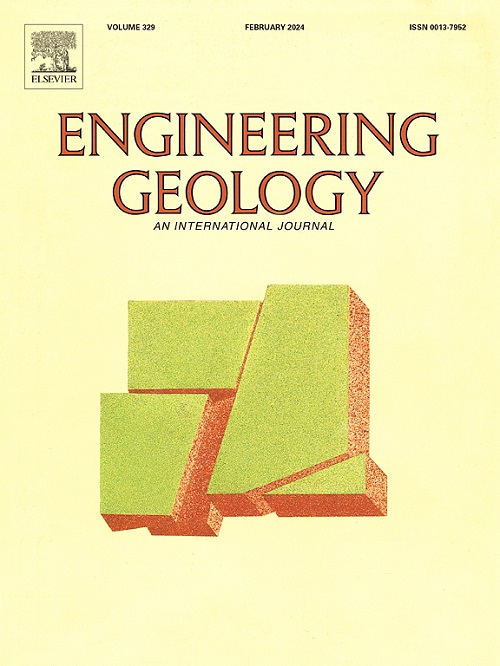Investigation on the breach mechanism of ice-containing blockage dams: Insights into the impact of ice melting on overtopping erosion
IF 6.9
1区 工程技术
Q1 ENGINEERING, GEOLOGICAL
引用次数: 0
Abstract
With global climate warming, ice avalanches have become increasingly frequent, often resulting in the formation of blocked dams. The presence of ice complicates the failure processes of these dams. Limited observations of breach processes and insufficient consideration of ice as a dam component impede the understanding of these processes. In this paper, a series of flume experiments were carried out to examine the effects of ice melting on overtopping breach mechanisms in dams. The results demonstrate that higher ice content enhances dam settlement and porosity, reducing structural stability. Dam height decreases from 30 cm (ice-free) to 18.5 cm at 60 % ice content, while void ratio increases from 0.82 to 1.73. These changes accelerate overtopping onset and reduce water storage capacity. The breach process can be divided into three stages: backward erosion, accelerated erosion, and attenuation-rebalancing. Both the duration of each stage and the total breach time decrease with increasing ice content. Peak discharge surges by 48.1 % (from 5.2 L/s to 7.7 L/s) at 30 % ice content and occurs 26.7 % earlier (from 172 s to 126 s). Beyond 30 % ice content, reduced water storage suppresses peak discharge (4.3 L/s at 60 % ice content). Ice melting creates new flow paths and enlarges pores in the dam, accelerating fine sediment transport and increasing dam heterogeneity. It also enhances erodibility index (from 0.0157 to 0.0516 cm·Pa−1·s−1) and reduces the critical shear stress (from 20.5 to 8.2 Pa) of dam materials. The ice phase modulates overtopping erosion process by controlling the erodibility of the dam materials and shear stress exerted by water flow. According to the ice content, three modes of erosion dynamics are revealed: enhanced amplification mode, attenuated amplification mode, and inhibitory breach mode. This study sheds light on the combined effects of internal ice melting and scour erosion in dams, providing valuable scientific insights for disaster prevention in glacial regions and paving the way for further research on the role of ice in dam breaches.
含冰淤塞坝溃决机制研究:融冰对溢流侵蚀的影响
随着全球气候变暖,冰崩变得越来越频繁,往往导致阻塞水坝的形成。冰的存在使这些水坝的破坏过程复杂化。对决口过程的有限观察和对冰作为大坝组成部分的考虑不足阻碍了对这些过程的理解。本文通过一系列水槽试验研究了冰融化对大坝溢流决口机制的影响。结果表明,高含冰量增加了坝体沉降和孔隙度,降低了结构稳定性。当含冰量为60%时,坝高由无冰状态下的30 cm下降至18.5 cm,空隙率由0.82上升至1.73。这些变化加速了过顶的发生,降低了水的储存能力。溃决过程可分为逆向侵蚀、加速侵蚀和衰减-再平衡三个阶段。各阶段持续时间和总溃决时间均随含冰量的增加而减小。冰含量为30%时,峰值放电增加48.1%(从5.2升/秒增加到7.7升/秒),提前26.7%(从172秒增加到126秒)。当冰含量超过30%时,储水量的减少抑制了峰值流量(冰含量为60%时为4.3 L/s)。冰融化创造了新的流动路径,扩大了大坝的孔隙,加速了细沉积物的运输,增加了大坝的非均质性。它还提高了大坝材料的可蚀性指数(从0.0157到0.0516 cm·Pa−1·s−1),降低了大坝材料的临界剪应力(从20.5到8.2 Pa)。冰相通过控制大坝材料的可蚀性和水流施加的剪切应力来调节过顶侵蚀过程。根据含冰量的不同,侵蚀动力学表现为三种模式:增强放大模式、衰减放大模式和抑制溃决模式。该研究揭示了大坝内部冰融化和冲刷侵蚀的综合影响,为冰川地区的灾害预防提供了有价值的科学见解,并为进一步研究冰在溃坝中的作用铺平了道路。
本文章由计算机程序翻译,如有差异,请以英文原文为准。
求助全文
约1分钟内获得全文
求助全文
来源期刊

Engineering Geology
地学-地球科学综合
CiteScore
13.70
自引率
12.20%
发文量
327
审稿时长
5.6 months
期刊介绍:
Engineering Geology, an international interdisciplinary journal, serves as a bridge between earth sciences and engineering, focusing on geological and geotechnical engineering. It welcomes studies with relevance to engineering, environmental concerns, and safety, catering to engineering geologists with backgrounds in geology or civil/mining engineering. Topics include applied geomorphology, structural geology, geophysics, geochemistry, environmental geology, hydrogeology, land use planning, natural hazards, remote sensing, soil and rock mechanics, and applied geotechnical engineering. The journal provides a platform for research at the intersection of geology and engineering disciplines.
 求助内容:
求助内容: 应助结果提醒方式:
应助结果提醒方式:


